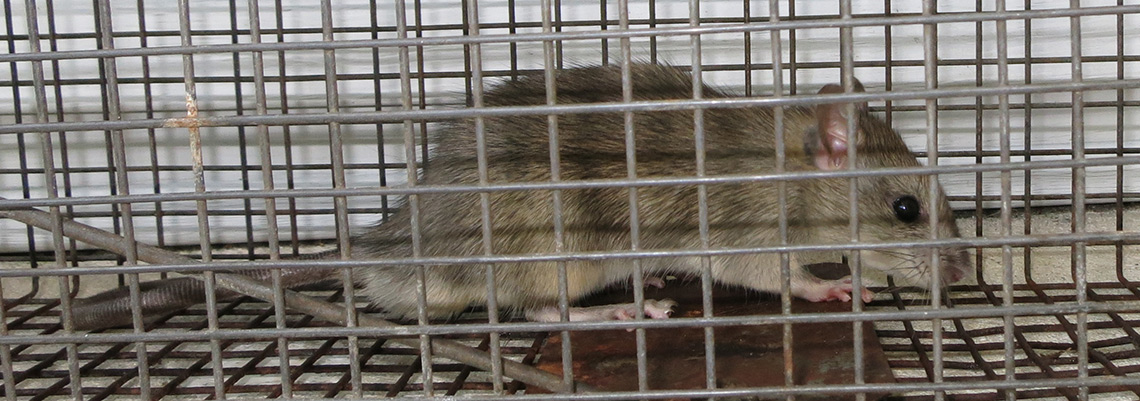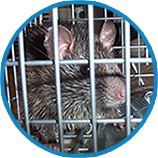Rat Removal - How to Get Rid of Rats
Rats - Problems They Cause, Methods of Removal and Prevention: Rats are particularly problematic vermin as they are known carriers of many diseases and cause significant damage to the structures they inhabit, with a single female rat being able to produce about five litters per year – sometimes as much as ten – with each litter containing seven to fourteen young, depending on food availability and current size of the rat group (if the rat population is just decimated and not exterminated, the remaining females will produce more litters or litters consisting of more babies, bringing the population back at its former glory in a matter of months). Invasive rats and mice are no pondering subject – if you notice these rodents roaming around your property or living in your home, you should act upon it post-haste.

Problems caused by rats
One of the biggest problems caused by rats is damage to the place they live in and to the surrounding objects available in that particular environment. For example, if you have a rat infestation in your attic, you can be sure that all the things you have stored up there will be messed with by the rats – they will infect it all with their waste, and cause damage to everything with their relentless chewing.
And never mind the destruction of your belongings, the even greater problem here is that they will chew through almost everything, including electrical wiring, insulation, wood, plastic, they will even chew through metal pipes (!) This is very bad news, first of all because this incessant chewing may cause short-circuits that can provoke fires, or lead to your household electrical appliances malfunctioning. Chewed through pipes can also lead to flooding situations, and chewing at the wood structure of your attic can lead to actual structural collapse.
If the rats are living in your attic, they're getting in either through access holes in the roof, or from the ground up traveling through the inside of your walls. Both scenarios are problematic, the latter being even more worrisome than you might think. If the rats are circulating inside your walls, there's always the chance that they might get stuck somewhere down the road, and die either due to lack of oxygen or lack of food and water. A dead rat in the wall is a very serious issue, not only because of the obvious part, the appalling odor of a disintegrating rat cadaver, but also because that particular smell can attract insects and arthropods that feed on animal remains. And these puny necrophagous species are not the only ones that will be enticed by the smell, other more dangerous animal species will also try their luck for an easy meal, animals like snakes and birds, or even more rats that will in turn get stuck themselves in the wall, adding to the problem and to the smell. Rats can also choose to raise their litters in inside the wall, which can be a problem if you exterminate the rat population in the attic – the litter will die and rot in the wall. This is less problematic than when an adult rat dies in the wall, because the young are very little and very thin, so they'll shrivel away quickly. Extracting a rat corpse from inside a wall can be a very expensive procedure if you can't reach it and grab it from somewhere and need to drill a hole in the drywall instead. Rats frantically searching for food in areas of your home where you actually live in will chew wires, furniture and through doors, and infect the food they or their droppings come in contact with.
Another major problem associated with rat invasion is disease. From plague, to rabies, to leptospirosis, to Hantavirus pulmonary syndrome – just to name the most common ones – both the Norway rat and the black rat are susceptible to carrying and transmitting these diseases to humans.
Methods of removal and prevention
The best and only true humane way to handle a rat problem is through lethal trapping with snap traps. The classic Victor wooden trap should be your best choice. All wildlife removal has its specifics depending on the animal in questions, and successful rat removal is right up there in the top in terms of removal difficulty level. When talking about rats that have moved inside your home, first you need to identify all access points and seal them shut with aluminum flashings or steel screens. Yes, in the case of rats, hole sealing is done prior to capturing the animals, and anything less than metal flashings or steel screens will fall short in preventing other rats to try and chew their way through back inside. Next, by carefully examining the rat tracks to establish their preferred routes, the snap traps need to set just right on these trails so that the job is done quickly and efficiently – about a dozen traps will do for your typical attic rat infestation. After trapping and disposal follows decontamination. Rat decontamination is serious work. You will need to vacuum all the droppings that you have access to with a strong vacuum cleaner, remove and replace heavily soiled insulation, and spray the space with a good strong odor eliminator that will also neutralize and eat at any bacteria left behind. Removal and decontamination need to be done with protective gear, including HEPA filter mask, and full biohazard suit for the cleanup. Other methods of removal such as poison, one-way funnels, one-way door cages, glue boards or glue traps will be inefficient. Glue traps and boards or poisons are nothing less than cruel and unusual punishment, and are almost guaranteed to lead to even more problems.
Like any other invasive species that are prosperous among humans, rats like the shelter and the food we provide. To try and prevent rats from settling on your property, you need to ensure they don't have any conceivable access to these two commodities. Trashcans need to have a secure lid or locking system and be kept inside if possible. If you feed other animals outside, any leftovers need to be put back inside as soon as the animal is done eating. Any other food sources they might find on your property need to contained as much as they possibly can be. Thorough interior and exterior home inspection needs to be performed, and all possible rodent entry points need to be sealed with metal flashings or steel screens. Woodpiles, tools, or anything the rat could use to climb on need to be put away from the exterior walls of the building.
If you decide to go with the recommended option here, hiring a wildlife removal professional, make sure that you're contacting an experienced expert – in what concerns rat removal, experience is always a very big plus, and can make the difference between a one-week job and a two-hour job. Don't make the mistake of hiring a big pest control company or an exterminator to solve your rat problem – simply put, they won't solve it. Be sure to ask your wildlife pro about their decontamination and repair services, as this needs to be done in order to discourage other rats that would want to set camp on your property.

Rat Removal - How to Get Rid of Rats
Do Rats Eat Cheese? Do They Really Like It
Do Rats Dig Holes?
How to remove a rats stuck down on a car?
How to get a rats out of your bedroom
Do rats bite sleeping babies?
How to get rats out of the garbage
What if you are bitten by a rat?
Do Rats Have Bones? How Can They Fit In Such Small Holes?
Do Rats Carry Rabies?
Do Rats Hibernate?
What Animals Do Rats Kill?
Humane rat traps
Will a rat chew through the ceiling?
What does rat feces look like? Where is it found?
Do Rats Jump? How High or How Far?
Do Rats Kill Mice?
Are rats dangerous to cats, dogs, or other pets?
Do Rats Destroy Insulation In The Attic?
Do Rodents like Rats and Mice Feel Pain?
How to get rid of rats in the attic
How to get rid of rats outside
Do Rats Swim?
How to get rid of rats in the attic
How big do rats get?
How smart are rats?
What attracts rats?
An analysis of inhumane glue traps for rats
Biology of Black Rat
What property modifications will keep down rat populations?
How rats communicate using pheromones
What are the types of rat snap traps?
Do rats enter a building through the plumbing?
How to inspect a house for rat entry holes
Biology of Norway rat
What can rats chew through?
What kind of damage do rats cause in an attic?
Will the city or county animal services help me with a rat issue?
Will a pest control company remove a rat?
How to find and remove a dead rat
Do rats chew on wires? Why?
Will homeowners insurance pay for rat damage?
Does poison make rats thirsty and die outside
What can a rat climb?
What should I do with a rat after I catch it?
What should I do if I find a nest of rats in the attic?
How do I clean rat feces out of my attic?
Do rats make good pets?
Will a rat in the attic have a nest of babies?
Where should I relocate a trapped rat?
What is a rat’s natural diet?
How to Get Rats Out Of a Wall
How to Keep Rats out of my Garden
How to keep rats out of my garbage
How do you remove a rat stuck in my dumpster?
How to get rats out of the attic
Do relocated rats survive?
Are cage traps a good option for rats?
What to do about a rat on the roof?
Is It Legal For Me To Trap A Rat?
How to use one-way exclusion funnels to remove rats without trapping them
What are some humane ways to kill a rat?
Will A Strobing Light Or High Pitch Sound Deterrent Machine Work On Rat?
What Is The Best Bait To Trap A Rat?
What are some of the symptoms of a sick rat?
Do Mothballs Or Ammonia Help Repel Rats?
Is rat feces dangerous to touch or breathe?
What equipment is needed to trap a rat?
What diseases do rats carry?
What to do about a trap-shy rat
What If A Rat Got Inside My House, Bedroom, Kitchen, Etc.?
Should I Hire a Pro or Remove Rats myself?
Do More Rats Live In The Urban Areas, Or Wild Areas?
Will repellents get a rat out of the attic?
What do wildlife rehabilitators do with rats?
Should I ever poison a rat?
What is a rat’s mating habit?
Does using poison cause dead rats in the house

